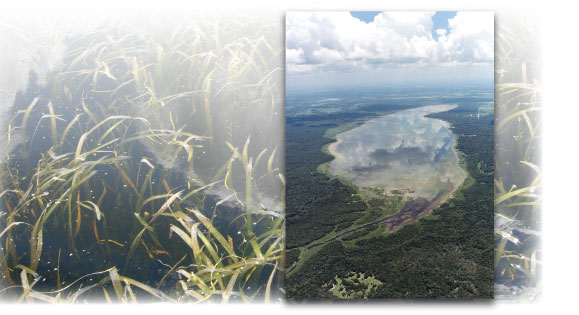Lake Panasoffkee water is clearer, eelgrass is thicker and fisheries are richer in response to the recent restoration project and effective management of lake levels, according to the District and Florida Fish and Wildlife Conservation Commission officials.
The lake continues to respond well following the dredging restoration project, which was completed in November 2008. The 10-year, $26.9 million project restored Lake Panasoffkee’s historic fish bedding areas and shoreline by removing approximately 8.3 million cubic yards of sediment from more than 1,744 acres of lake area.
“Currently conditions are excellent,” said Philip Rhinesmith, District senior environmental scientist. “There are desirable species of submerged aquatic plants covering nearly 80 percent of the lake bottom. With a high percentage of the lake colonized by desirable submerged aquatic plants, duck hunters are anticipating an excellent year.”
Eelgrass and other desirable plants covered only half of the lake bottom before the restoration project began. Rhinesmith said that water chemistry and clarity are excellent and fish camps and anglers are reporting good catches of largemouth bass, redear sunfish and bluegill.
Marty Hale, regional fisheries administrator for the Florida Fish and Wildlife Conservation Commission Northeast Region, agreed that fishing is improving on the lake.
“The presence of submersed aquatic vegetation is critically important for the growth and development of vibrant fish populations,” said Hale. “Sampling conducted near the end of lake restoration and following restoration showed higher catch rates of largemouth bass than ever recorded.”
Hale said that the catch rates for bluegill were also excellent, and surveys of anglers have verified the results.
Lake Panasoffkee is designated as an Outstanding Florida Water by the Florida Department of Environmental Protection, is one of the District’s Surface Water Improvement and Management (SWIM) priority water bodies and is a nationally acclaimed fishery.
Since the 1940s, approximately 900 acres of open-water habitat had been lost due to the accumulation of natural sediments over the hard lake bottom. The additional sediment caused large portions of the lake to become shallow enough for emergent vegetation to take hold. The buildup of sediment adversely impacted the historic fish spawning areas and limited navigation around the lake.
A four-step restoration plan, developed by the Lake Panasoffkee Restoration Council and managed by the District, began in Sept. 2000. The restoration project was funded by multiple partners, including the state of Florida, the U.S. Environmental Protection Agency, the District’s Withlacoochee River Basin Board and SWIM Program, the Florida Fish and Wildlife Conservation Commission, the Florida Department of Transportation and Sumter County.

